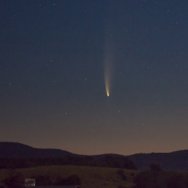
Comets Blog
Comets News Headlines
Catch Comet Swan
4/9/2025
Read More
Meteors Shed Light on Comet Composition
8/22/2024
In
a study recently published in Icarus, researchers using visual and video
observations of 47 young meteor showers have found differences in the
sizes of meteoroids produced by short-period and long-period comets. The
difference in meteoroid sizes may be a relic of the conditions in the
early solar system when these objects formed. Jupiter-family comets
usually crumble into smaller, denser meteoroids, whereas long-period (Oort
Cloud) comets often crumble into sizes indicative of gentle accretion
conditions.
Read More
Comet's impact triggered downfall of ancient Hopewell?
2/1/2022
The rapid decline of the Hopewell culture about 1,500 years ago might be explained by falling debris from a near-Earth comet that created a devastating explosion over North America, laying waste to forests and Native American villages alike. Researchers found evidence of a cosmic airburst at 11 Hopewell archaeological sites in three states stretching across the Ohio River Valley.
Read More
